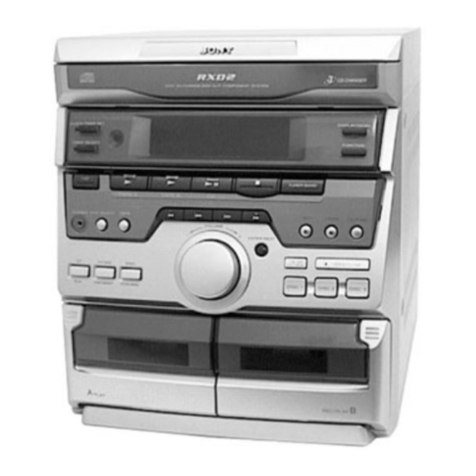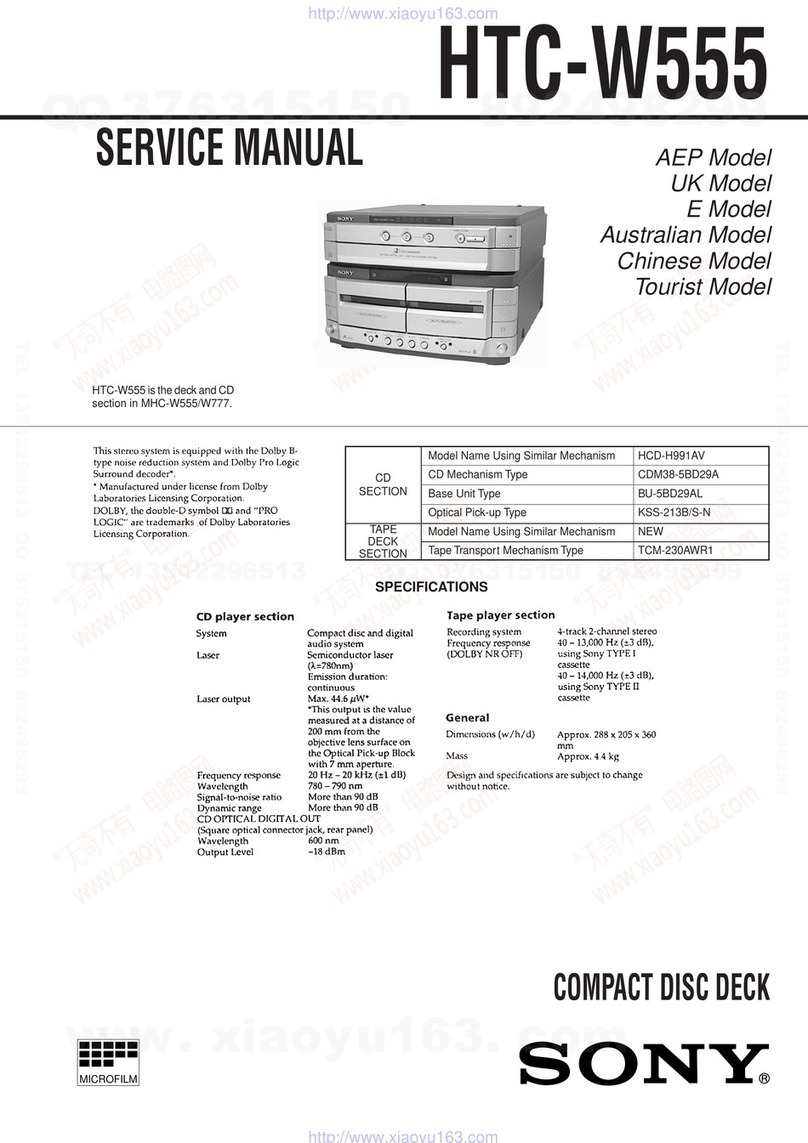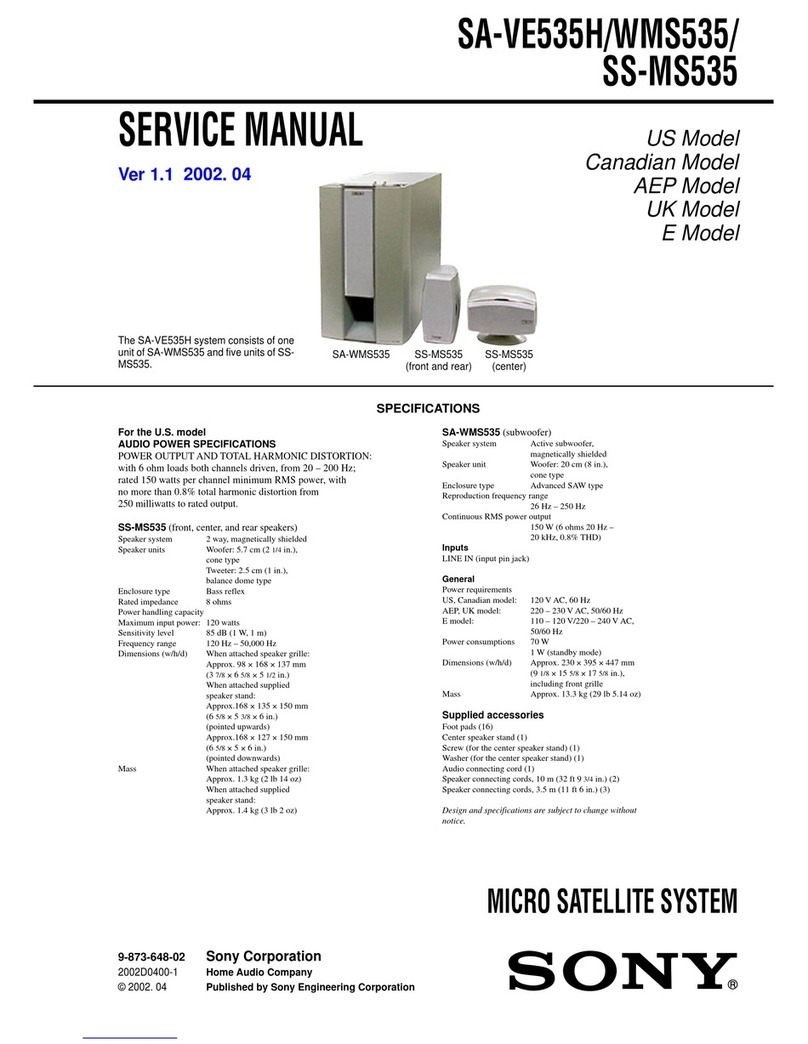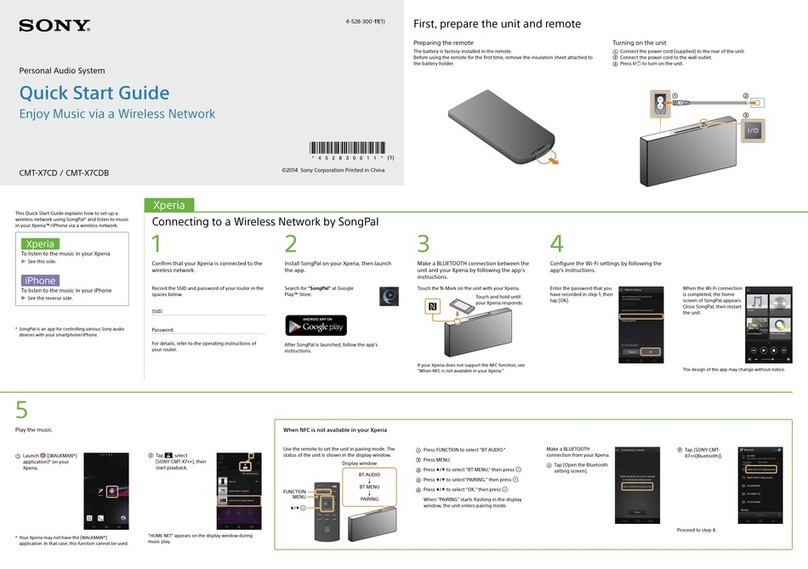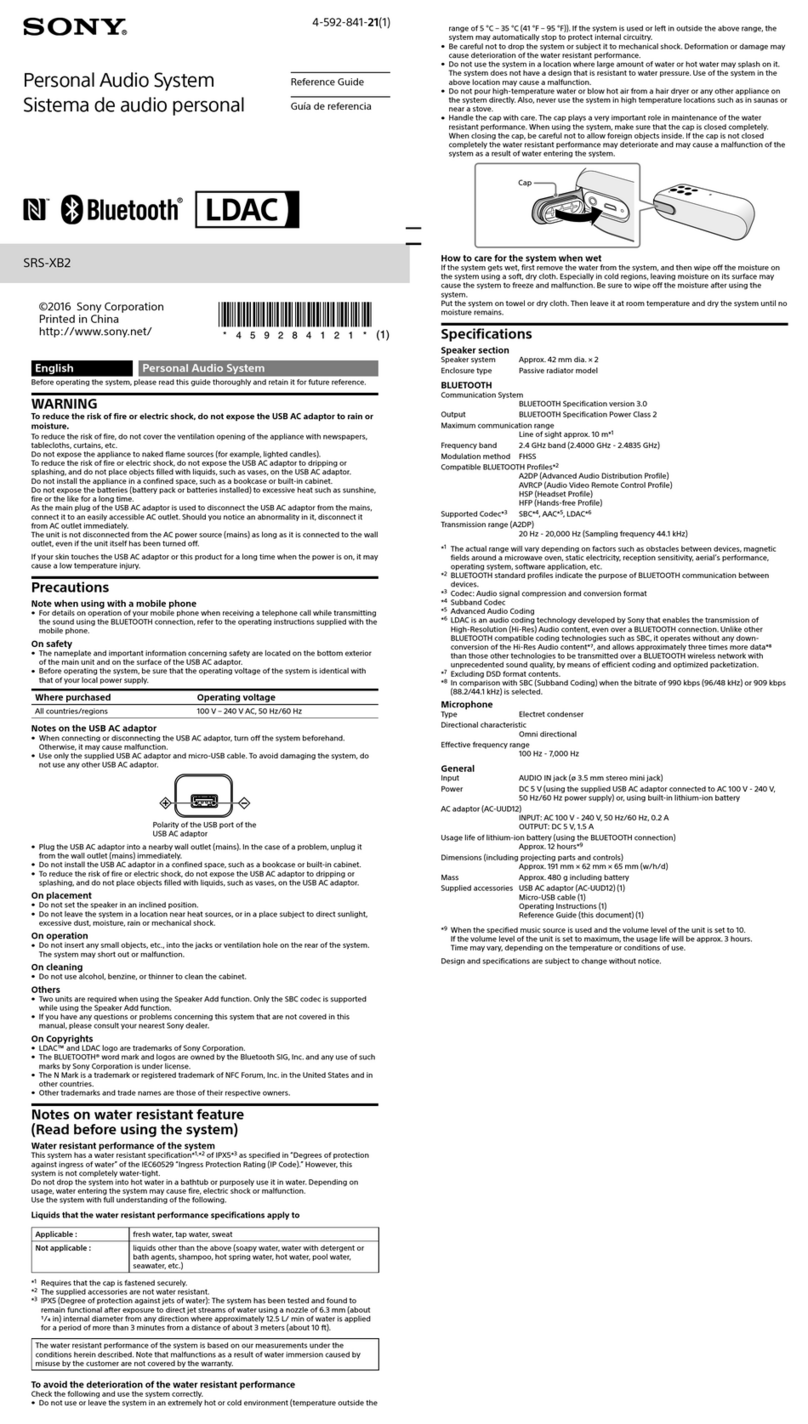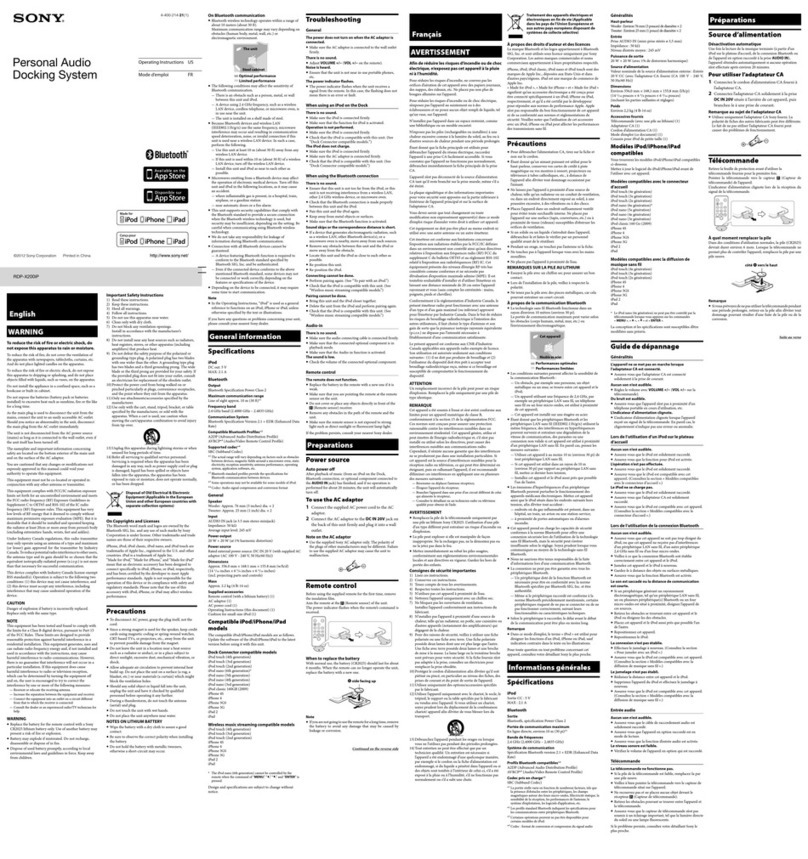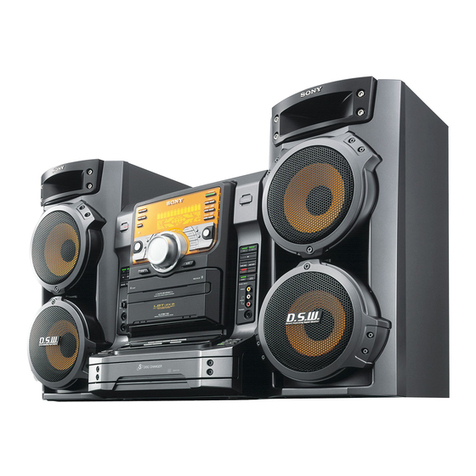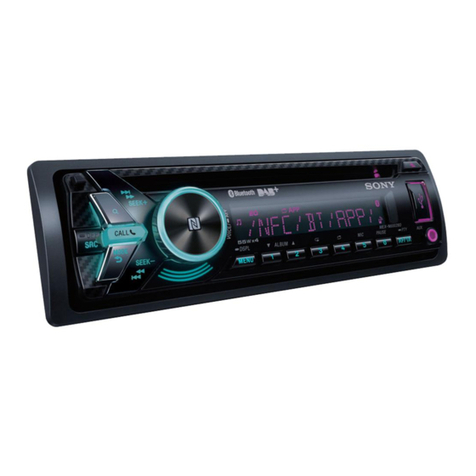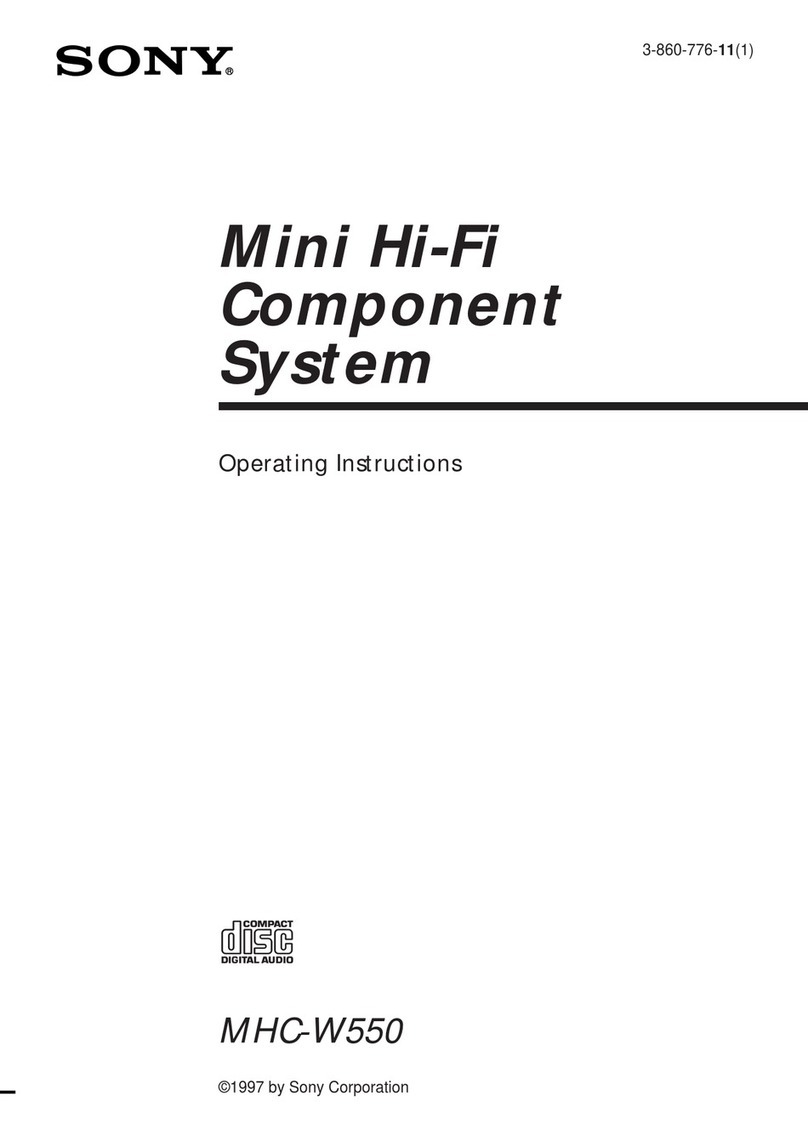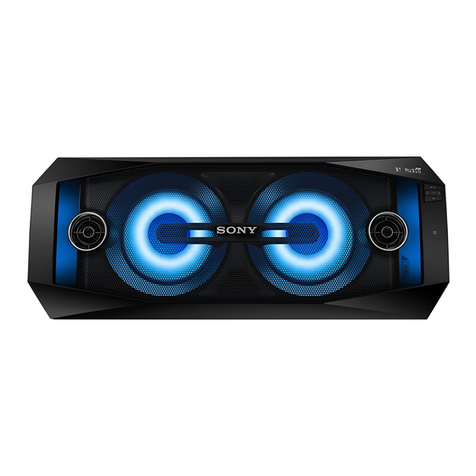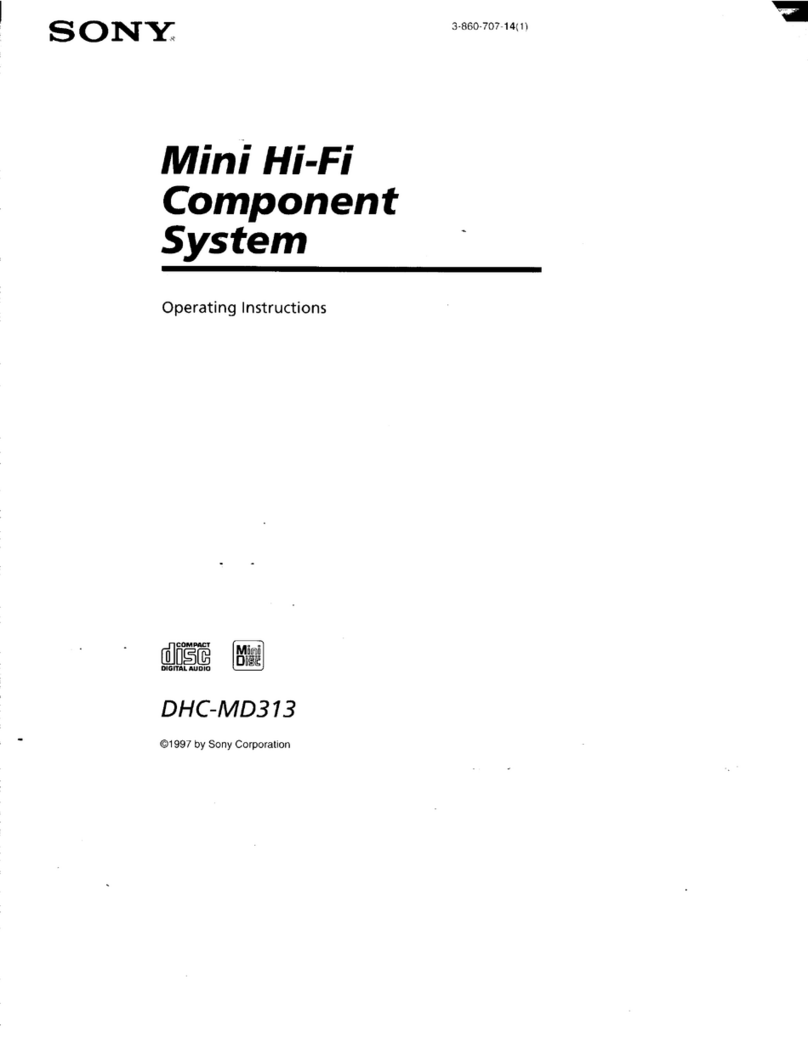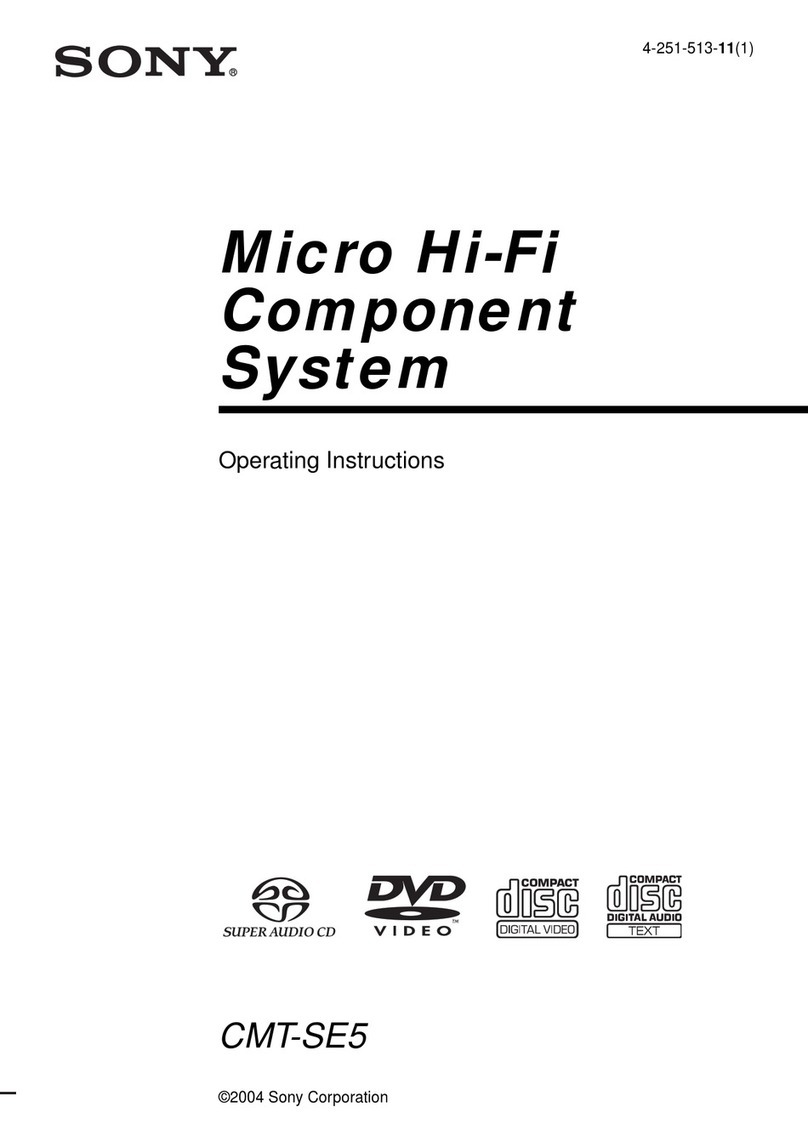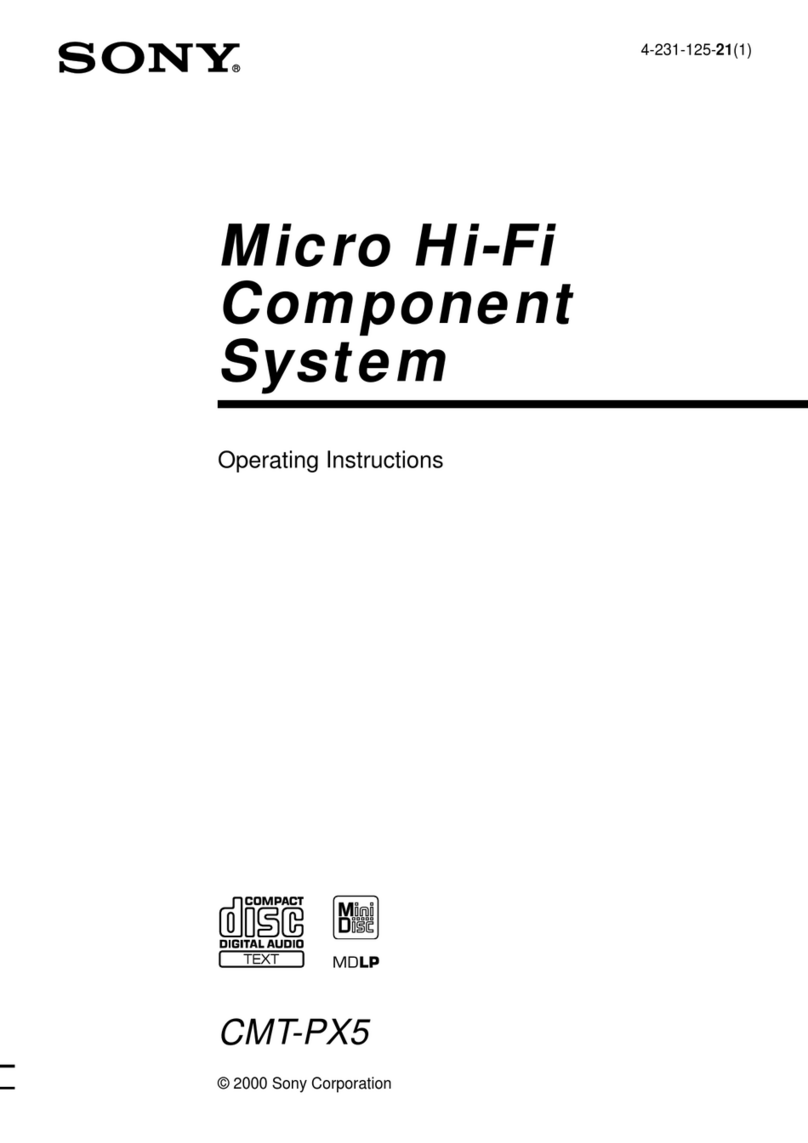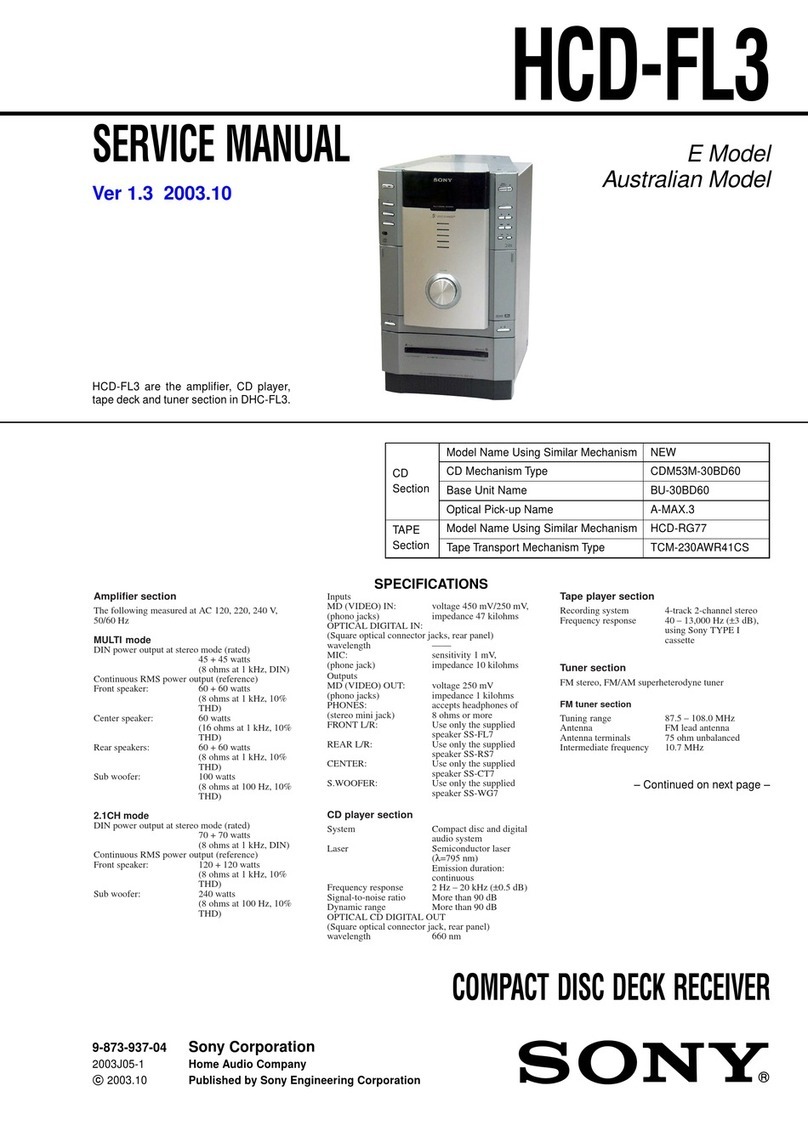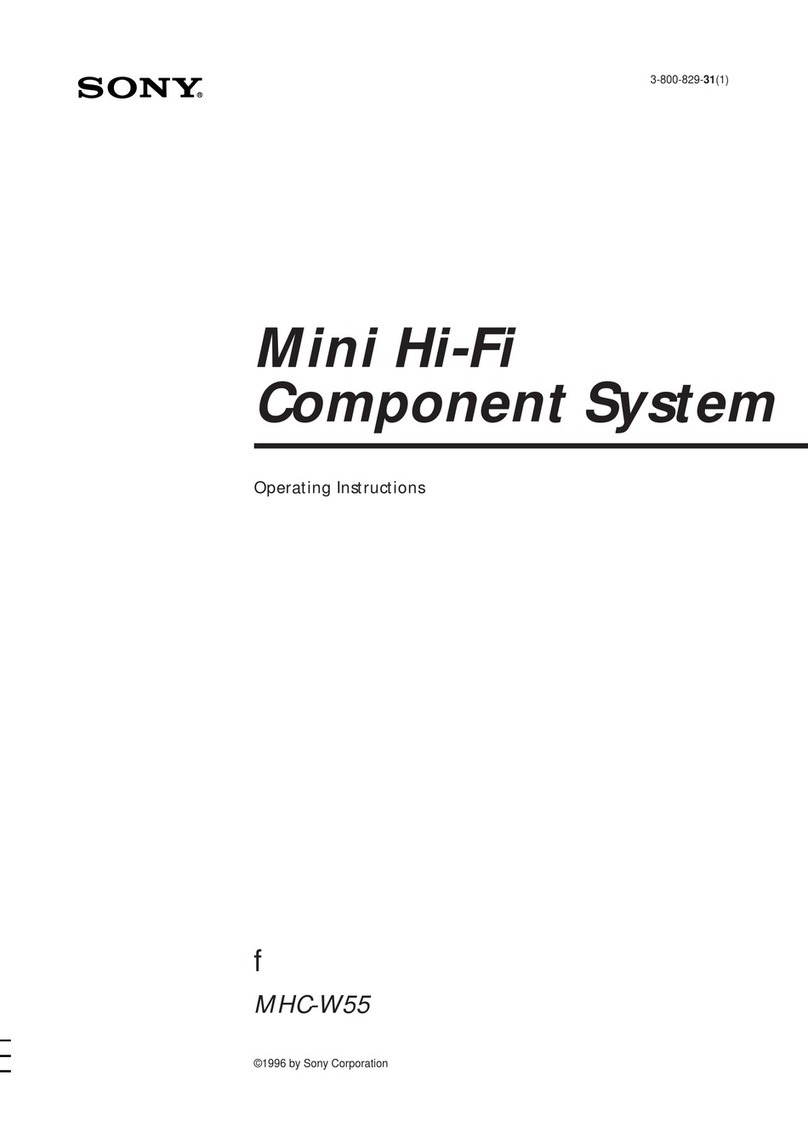
4
HCD-CPZ1DAB SECTION 2
GENERAL
Basic Operations
Before using the system
To use the remote
Slide and remove the battery compartment lid
wk
, and
insert the two supplied R6 (size AA) batteries, Eside
first, matching the polarities shown below.
Notes on using the remote
•With normal use, thebatteries should last for about six months.
•Do not mix an old battery with a new one or mix dierent types of
batteries.
•If you do not usethe remote for a long per iod of time, remove the
batteries to avoid damage from battery leakage and corrosion.
To set the clock
1Turn on the system.
Press I/1 (power)
1
.
2
Select the clock set mode.
Press C L OCK / T I M ER SET
wg
on theremote. If the
current mode appears on the display, press ./>
qa
on the remote repeatedly to select “CLOCK SET?”
and then press ENTER
qd
on the remote.
3
Set the time.
Press ./>
qa
on the remote repeatedly to set
the hour, and then press ENTER
qd
on the remote.
Use the same procedure to set the minute.
The clock settings are lost when you disconnect the
power cord or if a power failure occurs.
To run the DAB Automatic Scan
When you turn on the system for the first time after
you purchase the system, DAB Automatic Scan starts
automatically and creates a list of available services.
If you want to run the DAB Automatic Scan again,
perform the procedure below.
1
Press DAB AUTO SCAN 6on the unit.
“DAB Auto Scan? Push ENTER” appears.
2
Press PUSH ENTER on the unit (or ENTER on the
remote) qd.
Scanning begins. “DAB Auto Scan” appears.
Depending on the DAB services available in your area,
scanning may take a few minutes.
When scanning is complete, a list of available services
is created.
Notes
• If your country or region does not support DAB broadcast, “No
Service” appears.
• Do not press any button on the unit or the remote during DAB
Automatic Scan. Scanning is interrupted and service list may not be
created properly. In this case, run the DAB Automatic Scan again.
• If you move to another area, repeat this procedure to store the
stations for your new area.
• This procedure clears all previously stored presets.
• Before unplugging the DAB antenna, make sure the system is turned
off to preserve your own DAB settings.
• This tuner does not support data services.
Selecting a music source
Press the following buttons (or press FUNCTION
8
repeatedly).
To sele ct Press
CD CD
qh
on the remote.
Tuner TUNER/BAND
q;
.
DAB DAB
wj
on the remote.
Tape TAPE
9
on the remote.
Component (connected
using an audio cord) FUNCTION
8
repeatedly
until “MD” appears.
Adjusting the sound
To adjust the volume
Press V O LUM E +/– on the remote (or turn the
VOLUME control on the unit)
qj
.
To add a sound effect
To Press
Generate a more
dynamic sound
(Dynamic Sound
Generator X-tra)
DSGX wf on the unit.
Set the sound effect EQ
wd
on the remote
repeatedly to select “BASS”
or “TREBLE,” and then
press +/–
qa
on the remote
repeatedly(orturntheBASS
or TREBLE control
wd
on the
unit) to adjust the level.
Playing a CD/MP3 disc
1
Select the CD function.
Press CD
qh
on the remote.
2
Load a disc.
Inserta disc inthe disc slot
ws
with the label sideup.
3
Start playback.
Press N(play)
e;
on the remote (or CD u(play/
pause)
qh
on the unit).
To Press
Pause playback X(pause) e; on the remote (or
CD u(play/pause)
qh
on the
unit). To resume play, press the
button again.
Stop playback x(stop)
qk
.
Remove a disc Press CD Z(eject)
qg
on the
unit.
Select a group on an
MP3 disc +/–
qf
. Or turn the jog dial
qs
on the unit and press PUSH
ENTER
qd
on the unit (turn the
jog dial
qs
on the unit during
playback until “GROUP” appears,
and then press PUSH ENTER
qd
on the unit to select the desired
group).
Select a track or file ./>(go back/go forward)
qa
. Or turn the jog dial
qs
on
the unit and press PUSH ENTER
qd
on the unit. To cancel, press
CANCEL
qk
on the unit.
Find a point in a
track or le Hold down m/M(rewind/
fast forward)
qa
during playback,
and release the button at the
desired point.
Select Repeat Play REPEAT
wh
on the remote
repeatedly until “REP” or
“REP1” appears.
To change the play mode
Press PLAY MODE
5
repeatedly while the player is
stopped. You can select normal play (“ ” for all MP3
files in the group on the disc), shue play (“SHUF”or
“SHUF*”), or program play (“PGM”).
*When playing a CD-DA disc, (SHUF) Play performs the same
operation as SHUF Play.
Notes on loading discs
•When you turn on the system, the disc is not pulled into the disc slot
until “No Disc” appears in the display. Do not attempt to push in the
disc until “No Disc” appears.
•If you load a disc that is not playable by this system, it will be ejected
automatically.
•Do not load an 8 cm disc with an adaptor. Doing so may cause the
system to malfunction.
•When you remove a disc, handle the disc by its edge and pull it
straight out of the disc slot. Do not touch the surface.
Note on the jog dial
Only the first 9 characters are displayed when performing the group
search, track search, or file search.
Notes on Repeat Play
•All tracks or les on a disc are played repeatedly up to five times.
•“REP 1” indicates that a single track or file is repeateduntil you stop
it.
Notes on playing MP3 discs
•Do not save other types of les or unnecessary groups on a disc that
has MP3 fies.
•Groups that have no MP3 les are skipped.
•MP3 les are played back in the order that they are recorded onto
the disc.
•The system can only play MP3 les that have a le extension of
“.MP3.”
•If there are les on the disc that have the “.MP3” file extension,
but that are not MP3 les, the unit may produce noise or may
malfunction.
•The maximum number of:
– groups is 256 (including the root folder).
– MP3 les is 511.
–
MP3 les and groups that can be contained on a single disc is 512.
– directory levels (the tree structure of les) is 8.
•Compatibility with all MP3 encoding/writing soware, recording
device, and recording media cannot be guaranteed. Incompatible
MP3 discs may produce noise or interrupted audio or may not play
at all.
Notes on playing multisession discs
•If the disc begins with a CD-DA (or MP3) session, it is recognized as
a CD-DA (or MP3) disc, and other sessions are not played back.
•A disc with a mixed CD format is recognized as a CD-DA (audio)
disc.
Listening to the radio
Before you can receive DAB, you must complete the
DAB Automatic Scan procedure (see “Before using the
system”).
1
Select “DAB,”“FM” or “AM.”
Press TUNER/BAND
q;
repeatedly. You can also
select DAB directly by pressing DAB
wj
on the
remote.
2
Select the tuning mode.
Press TUNING MODE
5
repeatedly until “AUTO”
appears.
3
Tune in the desired station.
Press +/– on the remote (or TUNING +/– on the
unit)
qa
. Scanning stops automatically when a station
is tuned in, and then “TUNED” and “STEREO” (for
stereo programs) appear.
When you tune in a DAB station or an FM station that
provides RDS services, the service name or station
name appears on the display.
To stop automatic scanning (FM/AM bands
only)
Press x(stop)
qk
on the remote.
To tune in a station with a weak signal (FM/AM
bands only)
If “TUNED” does not appear and the scanning does not
stop, press TUNING MODE 5repeatedly until “AUTO”
and “PRESET” disappear, and then press +/– on the
remote (or TUNING +/– on the unit)
qa
repeatedly to
tune in the desired station.
To reduce static noise on a weak FM stereo
station
Press FM MODE
wh
on the remote repeatedly until
“MONO” appears to turn off stereo reception.
Notes on listening to DAB stations
•When tuning in a DAB station, it may take a few seconds before you
hear any sound.
•Primary service is automatically received when secondary service
ends.
Playing a tape
1
Select the tape function.
Press TAPE
9
on the remote.
2
Insert a tape.
Press TAPE Z(eject)
9
on the unit, and load a TYPE
I (normal) tape into the cassette holder with the side
you want to play facing forward. Make sure there is
no slack in the tape to avoid damaging the tape or the
tape deck.
3
Press DIRECTION
5
on the unit repeatedly to select
“g” to play one side. Select “h” or “j” to play
both sides.
4
Start playback.
Press N(play)
e;
on the remote (or TAPE nN
(play)
9
on the unit). Press the button again to play
the reverse side.
To Press
Pause playback X(pause)
e;
on the remote (or
TAPE X(pause)
e;
on the unit).
To resume play, press the button
again.
Stop playback x(stop)
qk
on the remote (or
TAPE x(stop)
9
on the unit).
Rewind or fast
forward m/M(rewind/fast forward)
qa
.
Tip
If you select “j” the tape deck stops automatically aer repeating
the sequence ve times.
Changing the display
To change Press
Information on
the display* DISPLAY
4,
repeatedly when the
system is on.
Display mode
(See below.) DISPLAY
4,
repeatedly when the
system is off.
*For example, you can view:
–CD/MP3 disc information such as the track or le number, group
name (during normal play), or the total play time (while the player
is stopped)
–DAB station information such as the service name, channel label,
preset number, frequency, DLS (Dynamic Label Segment), or
ensemble label
The system oers the following display modes.
Display mode When the system is off,
1)
Clock The clock is displayed.
Power Saving
Mode
2)
The display is turned off to conserve
power. e timer and clock continue
to operate.
1)
The STANDBY indicator lights up when the system is off.
2)
When the system is in Power Saving Mode, the following functions
are unavailable:
–setting the clock.
–changing the CD power manage function.
Notes on the display information
•The following are not displayed;
– total playing time for a CD-DA disc depending on the play mode.
– total playing time for an MP3 disc.
– remaining playing time for an MP3 file.
•The following are not displayed correctly;
– elapsed playing time of an MP3 le encoded using a VBR (variable
bit rate).
– group and le names that do not follow either the ISO9660 Level
1, Level 2 or Joliet in the expansion format.
•The following are displayed;
– ID3 tag information for MP3 les when ID3 version 1 and version
2 tags are used.
– up to 124 characters of ID3 tag information using uppercase
letters (A to Z), lower-case letters (a to z), numbers (0 to 9), and
symbols (! " # $ % & ’ ( ) * + , – . / : ; < = > ? @ [ \ ] ^ _ ` { | } ~).
– up to 16 characters of service name, up to 128 characters of DLS
(Dynamic Label Segment) and up to 16 characters of ensemble
label using uppercase letters (A to Z), lower-case letters (a to z),
numbers (0 to 9), and symbols (! " # $ % & ’ ( ) * + , – . / : ; < = > ?
@[ \ ] ^ _ ` { | } ~).
Using optional audio components
To connect an optional headphones
Connect headphones to the PHONES jack
ql
on the
unit.
To connect an optional analog component
Connect additional analog component to the ANALOG
IN jack
w;
on the unit using an audio analog cord (not
supplied). Turn down the volume on the system, and
then press FUNCTION
8
repeatedly to select “MD”.
To connect an optional digital component
Connect a component with a digital optical input jack
to the CD DIGITAL OUT jack
wa
on the unit using
a digital optical cord (square, not supplied). You can
digitally record from a CD-DA disc onto the connected
component.
Note
You cannot make a digital recording of copy guarded discs and MP3
tracks using a digital component connected to this system.
This section is extracted from
instruction manual.
